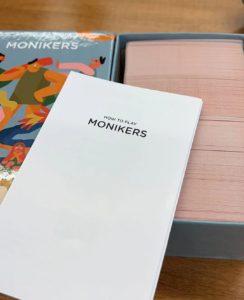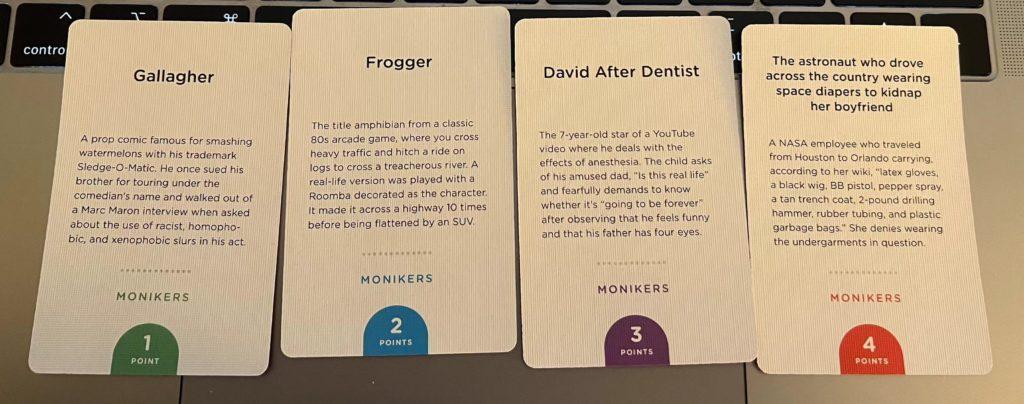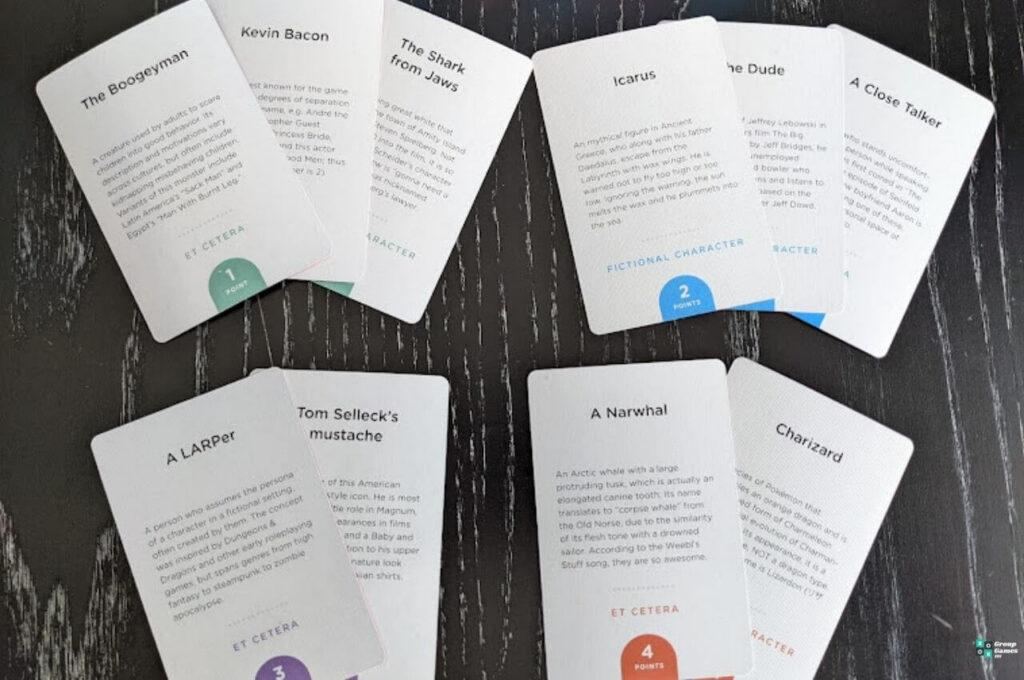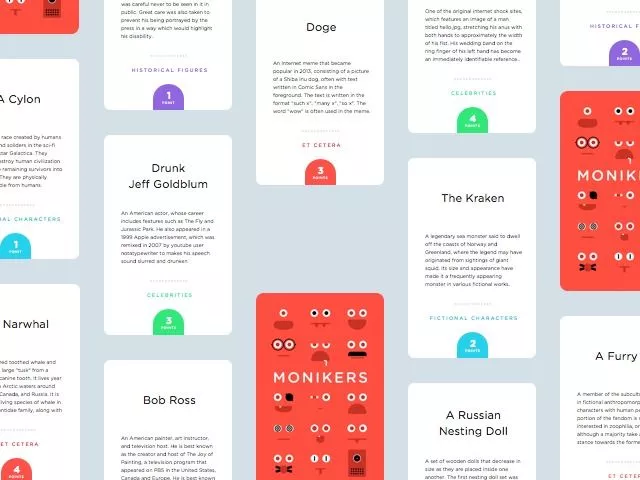Our game
Our game is “What’s your story”, a social game that facilitates connection building in family/friend gatherings. In our game, players will pair up to act out fictional characters and scenes together by randomly drawing character and scene cards from the deck. Other players will guess what characters they are and what scene they are acting out. For example, player A gets a “hopeless doctor” character and player B gets a “professional gamer” character, and they as a team gets the scene “flirting in a bar”. Other players will not see their cards. Then the team will have 1 minute to act out what their characters will do in that scene. Other players will guess after their 1-minute acting. Players score by guessing correctly and being guessed correctly.
Monikers
A competitive game that also involves acting and guessing is Monikers. It is created by CMYK (formerly called Palm Court.) In terms of platform, it can be played with cards in person or with a simulator website online (https://www.playmonikers.com/). The theme of it is social, guessing, and party game. The target players are people older than 17 years old and the purpose of the game is for people to build connections. These are very similar to our game “What’s your story”, so I chose Monikers to analyze as a competitive game.

Formal Elements & Mechanics
In Monikers, players will split into two teams. The interaction pattern of players would be a team competition. Each player chooses a number of cards and put them all together to collectively build a deck with around 40-50 cards in total. Players will use this deck to play three rounds of games.
On each card, there will be a “name” to guess, a “clue” that describes the “name”, a “category” that the “name” fits into, and “points” (1 pt – 4 pt) that the team will get from guessing that card right. The “names” are not strictly names of people but can be names of anything like movies, celebrities, song lyrics, or slang. It could even be a totally arbitrary line. I drew a card with each point randomly and took a picture to demonstrate.

In each round, teams take turns to go through the deck for 1 minute and try to get as many as possible. In that minute, in the team, one person will show without telling the “name” itself to let their teammates guess the “name” correctly. Players can skip as many cards as they want. Within each minute, players in the team will go one by one to be the actor and repeat when everyone has gone once. Teams get to keep the cards they guess correctly and skipped cards will be shuffled back to the deck. A round ends when all cards in the deck are correctly guessed.
There are different rules for acting in each round. Round 1, say anything about the name, just don’t say their name. Round 2, only use one word to hint at the name, without any gestures or sounds. Round 3, perform charades to get the team to guess the name. The cards get shuffled, but don’t change between round 1 and round 3, so creating clever hints in round 1 that can be paired down in rounds 2 and 3 are important for success.
Resources of this game include time and cards. The objective of this game is to capture as many cards as possible and outwit the other team. The outcome will be one team winning by earning more points collectively in the three rounds.
Types of Fun

The one that stood out the most was fellowship. Playing this game not only strengthened the bonding within teams but also between teams. Because we can learn from how the other team acts and maybe use it in another round when we encounter the same card. It is also possible that although your teammates don’t get what you are acting, the other team might understand what you are doing. Although the two teams are competing, the “names” are so funny that both teams will end up laughing together all the time, which facilitates bonding!
This game also allows for expression because players can use whatever way to convey the message. The three different rules of three rounds create more dynamics in the game by making players express the “names” in different ways.
Design, Handling of Abuse, and Comparison with other guessing games

The graphic design of this game is very simple. They are just a bunch of cards with words printed on them. I found the design very clean and straightforward. There is a lot of white space to display the hierarchy of information and relationships between elements. The “name” and the “clue” are black, and the “category” and the “points” are color-coded. There is also a dotted line between “clue” and “category”. With these design decisions, it is easy for players to pick out the information elements they need from the cards just at a glance, which is very helpful given the racing nature of this game. Because this is a social game, the simplicity of game equipment facilitates the goal of focusing on people. The game is also super portable and can be played anywhere.

One common abuse in social games is some people might be left out of the group when playing. I think the “clues” given by the designers are helpful in handling that abuse. Because I am not familiar with pop culture in the U.S., I always have trouble playing some guessing games that only write the “names” on their cards without any explanations. I feel very left out when everyone else is laughing at something I don’t get. To be honest, I didn’t know 80% of the cards of the deck I played in Monikers. However, I could read the “clues” to learn what they are to understand why people laugh. Therefore, I think this design protects the feeling of players with less background knowledge.
Relevant to the same abuse, another design that I really appreciated was that the same deck is used for three rounds. Although I didn’t know 80% of the cards in the first round, I can learn them while playing. So, in the second round, I will know much more cards than in the first round. This game doesn’t require as much background knowledge, which is a life-saver for foreigners to specific cultures.
There is certainly abuse that is not handled. Stereotypes are inevitable in guessing games. Although designers provided clues, it was still up to the players to decide how to act out the “names”. It might be helpful to design some rules to discourage stereotypes and biases when acting. For example, if some player exhibits bias in the acting of a card, their team will lose the points associated with that card. Players should also have the power to leave the game anytime when they feel like to with no pressure.
What would I change to make it better?
Besides adding rules to handle abuse as I mentioned, I also want to add a possibility for players to draw out the “name”. Currently, the game is mostly vocal and physical. Adding a drawing option can make the game more accessible to people who have trouble speaking or acting out scenes physically.



